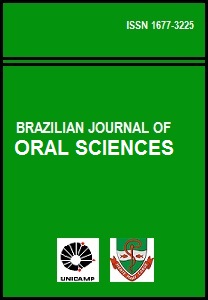Abstract
The study evaluated the effect of shade and composition in the production of heat during the dental composite photoactivation. Filtek Z 250 and Esthet X in the shades A3 and B1 and Filtek Flow and Natural Flow in the shades A3 and B2 were used. The temperature was registered using a type-K thermocouple connected to a digital thermometer with an accuracy of 0,1°C. A chemically polymerized acrylic resin base was built as thermocouple guide and support for a dentin disk, obtained from bovine tooth to simulate the remaining dentin in the cavity. On the acrylic resin base was adapted a matrix made of silicone. A light source emitted by XL 2500 halogenic lamp unit was used for a photoactivation time of 20 seconds. Eight groups were established in agreement with the interaction materials and shades (n=10). Obtained values were submitted to ANOVA and the averages to Duncan’s test (5%). The results showed that there was not statistical difference among the averages of the temperature increases in the same composite with different shades. There was statistical difference among the averages of the temperature increases in different composites in the same shades.
References
Peutzfeldt A. Resin composites in dentistry: the monomer systems. Eur J Oral Sci. 1997; 105: 97-116 2. Moszner N, Salz U. New developments of polymeric dental composites. Prog Polym Sci. 2001; 26: 535-76.
Anusavice K. Philip’s science of dental materials. 11th ed. St. Louis: Elsevier; 2003.
Guggenberger R, Weinmann W. Exploring beyond methacrylates Am J Dent. 2000; 13(Spec issue): 82D-84D.
Knezevic A, Tarle Z, Meniga A, Sutalo J, Pichler G, Ristic M. Degree of conversion and temperature rise during polymerization of composite resin samples with blue diodes. J Oral Rehabil 2001; 28: 586-91 6. Rueggeberg FA. Contemporary issues in photocuring. Compend. 1999; 20: S4-S15.
Andrzejewska E. Photopolymerization kinetics of multifunctional monomers. Prog Polym Sci. 2001; 26: 605-65.
Uhl A, Mills RW, Jandt KD. Polymerization and light-induced heat of dental composites cured with LED and halogen technology. Biomaterials. 2003; 24: 1809-20.
Lisant VF, Zander HA. Thermal injury to normal dog teeth: in vivo measurements to pulp temperature increases and their effect on the pulp tissue. J Dent Res. 1952; 31: 548-58.
Zach L, Cohen G. Pulp response to externally applied heat. Oral Surg Oral Med Oral Pathol. 1965; 19: 515-30.
McCabe JF. Cure performance of light-activated-composites by differential thermal analysis (DTA). Dent Mater. 1985; 1: 231-4.
Shortall AC, Harrington E. Temperature rise during polymerization of light-activated resin composites. J Oral Rehabil. 1998; 25: 908-13.
Masutani S, Setcos JC, Schinell RJ, Philips RW. Temperature rise during polymerization of visible light-activated composite resins Dent Mater. 1988; 4: 174-8.
Hansen EK, Asmussen E. Correlation between depth of cure and temperature rise of a light-activated resin. Scand J Dent Res. 1993; 101: 176-9.
Goodis HE, White JM, Andrews J, Watanabe LG. Measurement of temperature gererated by visible-light-cure lamps in an in vitro mode. Dent Mater. 1989; 5: 230-4.
Loney RW, Price RBT. Temperature transmission of High-output light-curing units through dentin. Oper Dent. 2001; 26: 516-20.
Arakawa H, Fujii K, Kanie T, Inoue K. Light transmittance characteristic of light-cured composite resins. Dent Mater. 1998; 14: 405-11.
Harrington E, Wilson HJ, Shortall AC. Light activated restorative materials: a method of determining effective radiation times. J Oral Rehabil. 1996; 23: 210-8.
Schneider LFJ, Cavalcante LMA, Tango RN, Consani S, Sinhoreti MAC, Correr-Sobrinho L. Pulp chamber temperature changes during resin composite photo-activation. Braz J Oral Sci. 2005; 4: 685-8.
Lloyd CH, Brown EA. The heats of a reaction and temperature rises associated with the setting of bonding resins. J Oral Rehabil. 1984; 11: 319-24.
The Brazilian Journal of Oral Sciences uses the Creative Commons license (CC), thus preserving the integrity of the articles in an open access environment.


